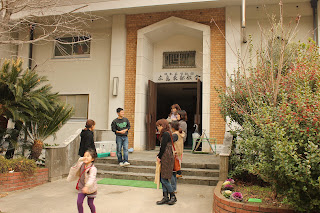To help us navigate future direction for transformation of Fukushima, Midori and I decided to learn deeper historical roots and wider social contexts of this nuclear crisis in Fukushima - the largest national crisis in Japan since the WW II. Thus we felt a trip to Hiroshima and Nagasaki seemed like a necessary step before we could move forward, especially for my trip to Chernobyl a few months ago opened our eyes that nuclear crisis is not simply an energy crisis. In Hiroshima, we went to visit a local church whose pastor has been involved in the peace movement for over four decades now.
Hiroshima Tobu Church of United Church of Christ in Japan
Rev. Tsukishita has been ministering this church for over forty years. American Missionaries from USA who came to work at a women’s mission school started the church in the 1930s, before World War II. After the war when all the American missionaries left Hiroshima, Tsukishita’s father came to this church. Tsukishita was only two years and eight months when the atomic bomb was dropped in Hiroshima. His memory of the disaster comes mostly from what he heard from his brother who was five years old at the time.
The Sun is Falling Down!
The two brothers were playing outside their home on August 6th, 1945 when the older brother said, “The Sun is falling down!” and they were blown away in the heavy wind blowing from the descending bomb. The atomic bomb dropping from the sky looked like a giant red ball, resembling the sun, to the eyes of witnesses on that day. The two children survived that day but the real struggle of fear of death and radiation sickness was just starting. For many years the Hiroshima City government announced a list at the end of December of the people who died of radiation sickness that year. The fear of death became especially real in the mind of young Tsukishita after a 12-year-old girl, who was at the same age as Rev. Tsukishita, suddenly died of radiation.
Growing up with such strong fear, Tsukishita sensed a growing desire in his heart that he wanted to help people remember this tragic historical event. After becoming a minister, he started a peace movement because he wanted to overcome the disaster not by anger and resentment, but with a renewed heart for peace building and reconciliation. He started teaching young people with puppets to help them remind the tragedy of Hiroshima. In addition to this initial peace movement, he also started organizing events and seminars, and prison-visiting ministries.
“Love one another,” the greatest command of Jesus, the ultimate peacemaker.
A turning point came in his peace movement when he visited Seoul, Korea in 1981. He was walking at Tapkol Park where the declaration of independence was publicly read on March 1, 1919 by the rising Korean elites. These elites were largely Christians who had been organizing underground national movements in the 1910s and 20s against Japanese occupation. Tsukishita heard a Korean elderly man shouting in Japanese behind him, which made him realize that he was not only a victim of the war but also an offender. For the first time, he saw the other end of the tragedy and started helping Korean Hibakusha, (Japanese for atomic bomb victims) in Hiroshima.
 |
| Rev. Tsukishita |
Tsukishita, the seasoned peace activist, says there are two ways of peace: “Pax Romana means simply absence of war, a society quieted by the control of those who have power. It is a reactive peace movement. But the truce peace movement, or proactive peace movement is different. It is not a controlled condition from outside, but it is rather a condition of heart, actively seeking wellbeing of others, by loving them and serving them because Jesus commanded, ‘Love one another.’” In the quiet but assertive voice of Rev. Tsukishita, the power of love and shalom is clear. This is the voice of a wounded healer.
Peace movements aren’t just about creating the loudest noise of “anti-“ campaigns, but rather are about sowing a small seed of sacrificial love or act of service in the heart of the other, according to Reverend Tsukishita. The sacrificial act of loving others starts small like a mustard seed, but it grows large and bears fruit. That’s what he hopes after forty years of quiet, resilient work for peace in his home city, Hiroshima.
No more pain, no more suffering.
As a young victim of the atomic bomb, Tsukishita’s deep motivation of starting a movement for peace was his determination: no more pain, and no more suffering. However, he has now realized that human power alone is never good enough to build peace. “I feel very sorry for what happened in Fukushima for I couldn’t do anything for them to prevent such a tragedy again.”
No More.
This “no more” is very powerful. Wherever we encounter volunteers rising up amongst disaster victims, this common sentiment is the backbone of everything they do. I am again witnessing story after story here in Fukushima from people who now selflessly love their neighbors because there was someone who had gone before them to prepare the way of this sacrificial love.
Greater love has no one than this: to lay down one’s life for one’s friends.
(John 15”:13)
 |
| the Old and the New: A-Bomb Dom under renovation |
 | |
| Peace Boulevard in Hiroshima - a rare scenery of urban landscape because most cities are built around narrow streets in Japan. |

No comments:
Post a Comment